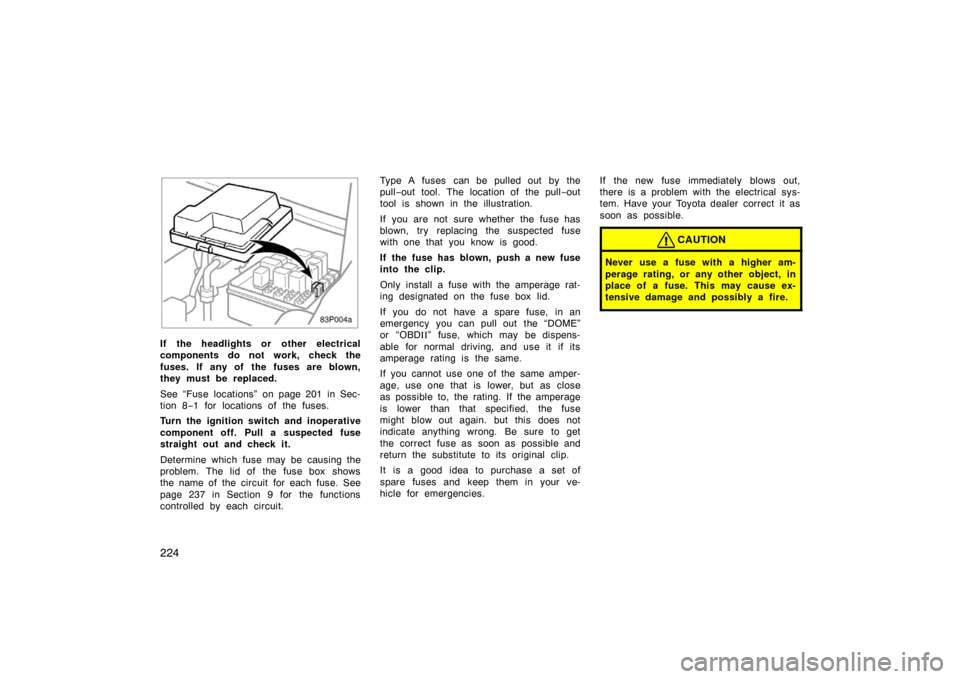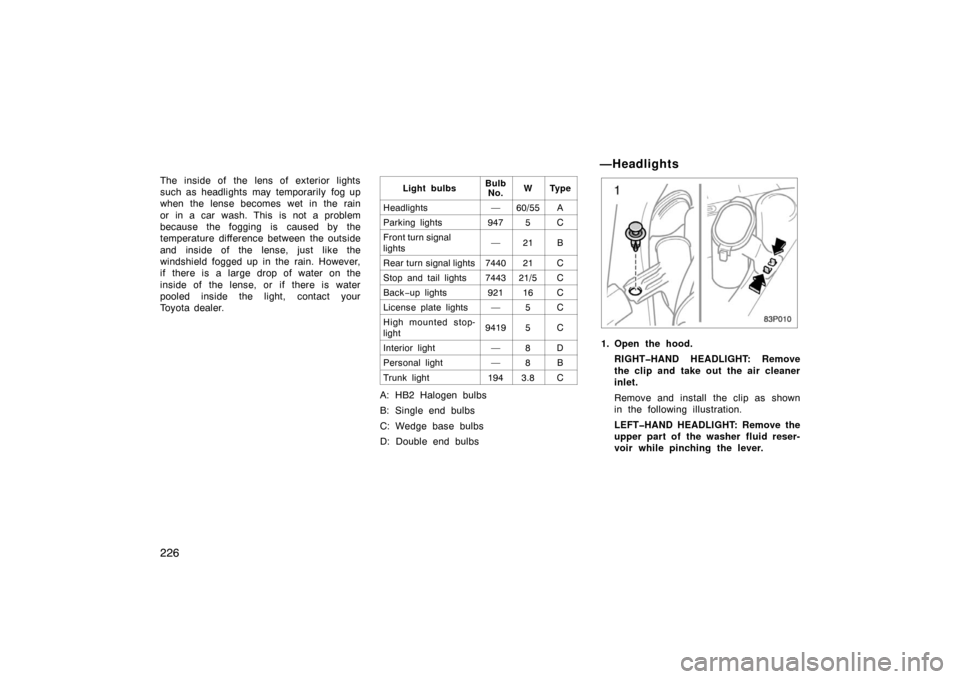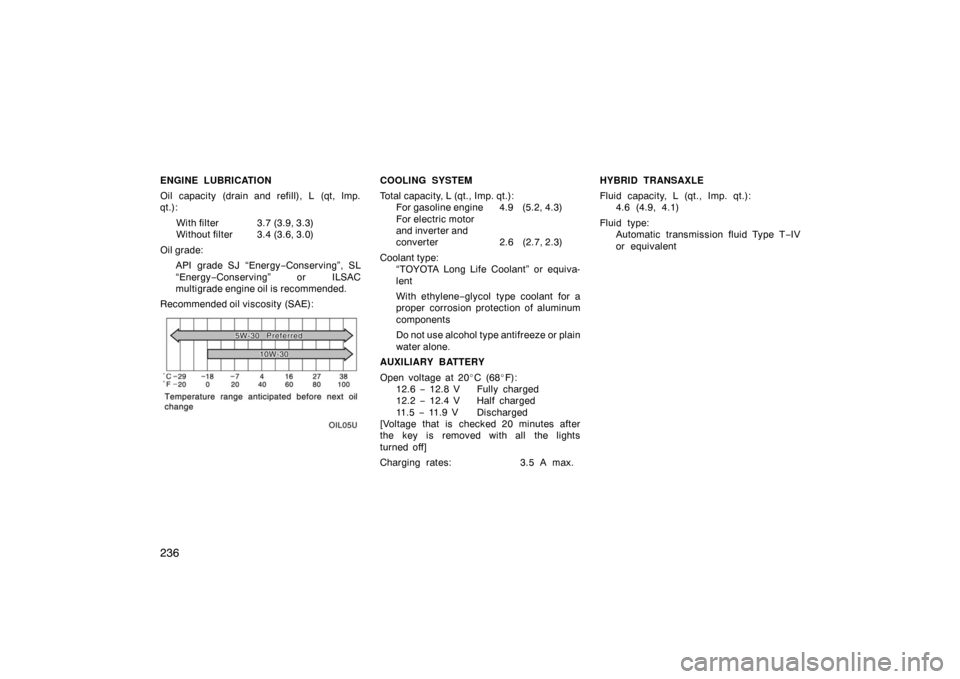Page 184 of 258

171
50p045a
Booster
battery
Negative
terminal
(“−
” mark) Jumper
cable
Discharged battery
Positive
terminal
(“+” mark)
c. Connect the clamp of the negative (black) jumper cable to the negative
(–) terminal on the booster battery.
d. Connect the clamp at the other end of the negative (black) jumper cable
to a solid, stationary, unpainted, me-
tallic point of the vehicle with the
discharged battery.
The recommended connecting point is
shown in the following illustrations:
50p043a
Connecting point
CAUTION
When making the connections, to
avoid serious injury, do not lean over
the battery or accidentally let the
jumper cables or clamps touch any-
thing except the correct battery termi-
nals or the ground.
10. Start the hybrid system. Make sure the “READY” light is on. If the hybrid ve-
hicle battery warning light comes on in
the multi −information display, the hybrid
vehicle battery is also discharged. Con-
tact your Toyota dealer.
11. Carefully disconnect the cables in the exact reverse order: the negative cable
and then the positive cable.
12. Carefully dispose of the battery cover cloths—they may now contain sulfuric
acid.
13. If removed, replace all the battery vent plugs.
If the cause of your auxiliary battery dis-
charging is not apparent (for example,
lights left on), you should have it checked.
Page 209 of 258

196
INSIDE THE VEHICLE
Items listed below should be checked
regularly, e.g. while performing periodic
services, cleaning the vehicle, etc.
Lights
Make sure the headlights, stop lights, tail
lights, turn signal lights, and other lights
are all working. Check headlight aim.
Service reminder indicators and warning
buzzers
Check that all service reminder indicators
and warning buzzers function properly.
Steering wheel
Be alert for changes in steering condition,
such as hard steering or strange noise.
Seats
Check that all front seat controls such as
seat adjusters, seatback recliner, etc. op-
erate smoothly and that all latches lock
securely in any position. Check that the
head restraint move up and down smooth-
ly and that the locks hold securely in any
latched position. For folding−down rear
seatbacks, check that the latches lock se-
curely. Seat belts
Check that the seat belt system such as
buckles, retractors and anchors operate
properly and smoothly. Make sure the belt
webbing is not cut, frayed, worn or dam-
aged.
Accelerator pedal
Check the pedal for smooth operation and
uneven pedal effort or catching.
Brake pedal
Check the pedal for smooth operation and
that the pedal has the proper clearance.
Check the brake booster function.
Brakes
At a safe place, check that the brakes do
not pull to one side when applied.
Parking brake
Check that the pedal has the proper travel
and that, on a safe incline, your vehicle
is held securely with only the parking
brake applied.
Hybrid transaxle ”Park” mechanism
Check the lock release button of the se-
lector lever for proper and smooth opera-
tion. On a safe incline, check that your
vehicle is held securely with the selector
lever in ”P” position and all brakes re-
leased.
IN THE ENGINE COMPARTMENT
Items listed below should be checked
from time to time, e.g. each time when
refueling.
Washer fluid
Make sure there is sufficient fluid in the
tank. See page 225 in Section 8
−3 for
additional information.
Coolant level
Make sure the coolant level is between
the ”FULL” and ”LOW” lines on the see −
through reservoir when the hybrid system
is cold. See page 210 in Section 8 −2 for
additional information.
Radiator, condenser and hoses
Check that the front of the radiator and
condenser are clean and not blocked with
leaves, dirt, or insects. See page 211 in
Section 8 −2 for additional information.
Page 237 of 258

224
83p004a
If the headlights or other electrical
components do not work, check the
fuses. If any of the fuses are blown,
they must be replaced.
See “Fuse locations” on page 201 in Sec-
tion 8−1 for locations of the fuses.
Turn the ignition switch and inoperative
component off. Pull a suspected fuse
straight out and check it.
Determine which fuse may be causing the
problem. The lid of the fuse box shows
the name of the circuit for each fuse. See
page 237 in Section 9 for the functions
controlled by each circuit. Type A fuses can be pulled out by the
pull
−out tool. The location of the pull −out
tool is shown in the illustration.
If you are not sure whether the fuse has
blown, try replacing the suspected fuse
with one that you know is good.
If the fuse has blown, push a new fuse
into the clip.
Only install a fuse with the amperage rat-
ing designated on the fuse box lid.
If you do not have a spare fuse, in an
emergency you can pull out the “DOME”
or “OBD II” fuse, which may be dispens-
able for normal driving, and use it if its
amperage rating is the same.
If you cannot use one of the same amper-
age, use one that is lower, but as close
as possible to, the rating. If the amperage
is lower than that specified, the fuse
might blow out again. but this does not
indicate anything wrong. Be sure to get
the correct fuse as soon as possible and
return the substitute to its original clip.
It is a good idea to purchase a set of
spare fuses and keep them in your ve-
hicle for emergencies. If the new fuse immediately blows out,
there is a problem with the electrical sys-
tem. Have your Toyota dealer correct it as
soon as possible.
CAUTION
Never use a fuse with a higher am-
perage rating, or any other object, in
place of a fuse. This may cause ex-
tensive damage and possibly a fire.
Page 239 of 258

226
The inside of the lens of exterior lights
such as headlights may temporarily fog up
when the lense becomes wet in the rain
or in a car wash. This is not a problem
because the fogging is caused by the
temperature difference between the outside
and inside of the lense, just like the
windshield fogged up in the rain. However,
if there is a large drop of water on the
inside of the lense, or if there is water
pooled inside the light, contact your
Toyota dealer.Light bulbsBulbNo.WTy p e
Headlights—60/55A
Parking lights9475C
Front turn signal
lights—21B
Rear turn signal lights744021C
Stop and tail lights744321/5C
Back −up lights92116C
License plate lights—5C
High mounted stop-
light94195C
Interior light—8D
Personal light—8B
Trunk light1943.8C
A: HB2 Halogen bulbs
B: Single end bulbs
C: Wedge base bulbs
D: Double end bulbs
—Headlights
83p010
1. Open the hood.
RIGHT�HAND HEADLIGHT: Remove
the clip and take out the air cleaner
inlet.
Remove and install the clip as shown
in the following illustration.
LEFT�HAND HEADLIGHT: Remove the
upper part of the washer fluid reser-
voir while pinching the lever.
Page 241 of 258
228
83p015a
4. Install the rubber cover as shown,and snuggle on the boss. Plug in the
connector.
Make sure the rubber cover fits snugly on
the connector and the headlight body.
Aiming is not necessary after replacing
the bulb. When aiming adjustment is nec-
essary, contact your Toyota dealer.
—Parking lights
83p016
83p017
83p010
RIGHT�HAND FRONT TURN SIGNAL
LIGHT: Remove the clip and take out
the air cleaner inlet.
Remove and install the clip as shown in
the following illustration.
LEFT�HAND FRONT TURN SIGNAL: Re-
move the upper part of the washer fluid
reservoir while pinching the lever.
—Front turn signal lights
Page 242 of 258
229
83P011
Removing clip
83p012
Installing clip
83p018
83p019
83p023
83p029
—Rear turn signal, stop/tail
and back�up lights
Page 244 of 258
231
83p026
Remove the cover clips.
83p027
83p028a
—License plate lights
Page 249 of 258

236
ENGINE LUBRICATION
Oil capacity (drain and refill), L (qt, lmp.
qt.):
With filter 3.7 (3.9, 3.3)
Without filter 3.4 (3.6, 3.0)
Oil grade: API grade SJ “Energy −Conserving”, SL
“Energy −Conserving” or ILSAC
multigrade engine oil is recommended.
Recommended oil viscosity (SAE):
oil05u
COOLING SYSTEM
Total capacity, L (qt., Imp. qt.): For gasoline engine 4.9 (5.2, 4.3)
For electric motor
and inverter and
converter 2.6 (2.7, 2.3)
Coolant type: “TOYOTA Long Life Coolant” or equiva-
lent
With ethylene− glycol type coolant for a
proper corrosion protection of aluminum
components
Do not use alcohol type antifreeze or plain
water alone.
AUXILIARY BATTERY
Open voltage at 20 �C (68 �F):
12.6 − 12.8 V Fully charged
12.2 − 12.4 V Half charged
11 . 5 − 11.9 V Discharged
[Voltage that is checked 20 minutes after
the key is removed with all the lights
turned off]
Charging rates: 3.5 A max.HYBRID TRANSAXLE
Fluid capacity, L (qt., Imp. qt.):
4.6 (4.9, 4.1)
Fluid type: Automatic transmission fluid Type T −IV
or equivalent